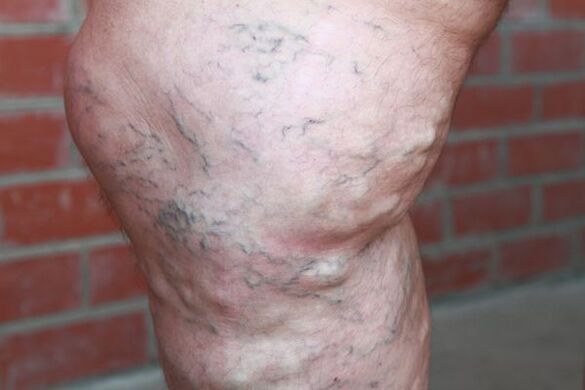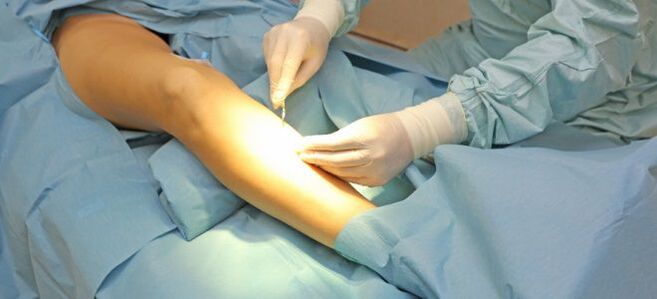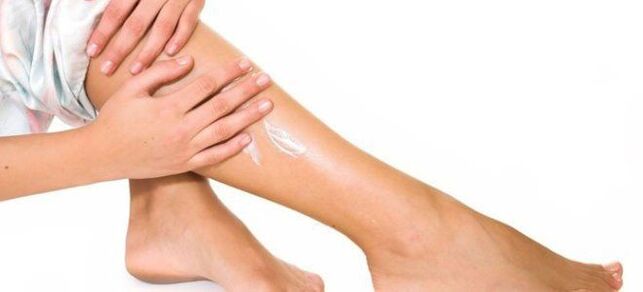Varicose veins are manifested when the veins stretch and increase in size, they acquire blue-violet or red shades, due to the accumulation of a large amount of blood.Varicosis is widespread disease and in most cases manifests itself on the legs, but at the same time it can also be formed in other parts of the body.

For most people, especially for women, varicose veins, first of all, is an aesthetic problem.In the first stages, the disease does not pose a threat to health.Swolled ugly veins can spoil the appearance of individual parts of the body, but if you do not pay attention to the treatment and prevention of varicose veins, complications can develop over time.
The causes of varicose veins
A number of factors can increase the risk of varicose veins:
- Hereditary predisposition.If someone from your family suffers from varicose veins, you have all the chances of inheriting the disease.
- Floor.According to statistics, varicose veins are more common in women than in men.
- Age.With age, veins and valves become weaker, and there is a probability of developing varicose veins.
- Violation of blood flow between arteries and veins.
- Hormonal changes.This is especially true for the period of pregnancy, the premenstrual period and menopause, when hormonal changes occur.In these periods, the risk of varicose veins increases.During pregnancy, the growing fruit presses on the veins in the legs.In this case, each subsequent pregnancy increases the risk of varicose veins.
- Obesity.Due to excess weight in the vein, too much pressure is too large, which can provoke the appearance of vaaricosis.
- "Sedentary" and "standing" work and a sedentary lifestyle.If you have to stand or sit for a long time, the risk of varicose veins increases.This happens for the reason that during a long stay without movement, the veins are more difficult to deliver blood to the heart.
The main symptoms of varicose veins
In addition to the characteristic formation of protruding dark blue or purple veins, these are the main signs of the development of varicose veins:
- Small swelling of the ankles and feet, especially after a long stay on the legs.
- Pain, burning and feeling of heaviness in the legs.
- Feet spasms and pulsation.
- Itching in the area of ankles and lower legs, which are often mistakenly diagnosed as dry skin.
- Change in skin color in the development of varicose veins (the appearance of bruises).
Treatment of varicose veins of the lower extremities
To effectively fight the problem of varicose veins, you need an integrated approach, which includes:
- Drugs for the treatment of varicose veins - tablets, capsules and drops;
- Local funds - creams, ointments and gels;
- Compression therapy;
- The right lifestyle;
- Moderate physical activity;
- Sparing and surgical methods (laser endenosis abtvia, sclerotherapy).
Compression therapy
When the first symptoms of varicose veins appear, it is recommended to start wearing compression clothing - stockings, tights or leggings create light pressure from the bottom of the legs, reducing blood accumulation and reducing edema.It is necessary to wear such compression clothing constantly, only in this case you can achieve a positive effect.Wearing compression clothing will not cure existing varicose veins, but will help prevent or reduce the increase in veins and further complications.
Sparing and surgical treatment methods
Laser endowous ablation (radiator or laser)
The method of laser endodenous ablation is today the most effective and safe way to treat varicose veins.It is the use of laser or radio -frequency therapy, with which the varicose veins is closed or removed.The doctor makes a tiny incision on the skin near the vein and inserts a catheter into it, then a special device is connected to the tip of the catheter, with which the catheter heats up and closes or removes the varicose vein (depending on the selected method of ablation).The procedure is performed using local anesthesia and the patient, as a rule, returns home on the same day.
Sclerotherapy
Sclerotherapy refers to sparing methods of treating varicose veins.During the procedure, a special substance is introduced into the veins affected by varicose veins, which destroys the inner shell of the vein and causes blood coagulation inside it.After some time, Vienna is destroyed and disappears.
Surgical method
In advanced cases of varicose veins, some, especially sparing treatment methods, are no longer effective.In this case, the patient suffering from varicose veins can help, during which the superficial vein is removed surgically.Indications for the operation are ulcers, bleeding, phlebitis.The operation is performed under general anesthesia, as a rule, the patient goes home on the same day.Within 2 weeks after surgery, pain and discomfort may be observed, this is normal.

Physical activity and terrestrial lifestyle
Training for varicose veins
Moving a lot and training a lot is the main allies in the fight against varicose veins.Not all training is equally useful, and some can even harm a person suffering from varicose veins.
Moderate rhythmic physical activity, such as walking prevents the progression of the disease and the development of complications, since dynamic muscle movements help direct blood from the periphery to the heart.
Walking is perfect for the prevention of varicose veins, this type of physical activity contributes to a healthy blood circulation by stretching and reducing the venous pump in the calf muscles.Walking at least 30 minutes at least 5 times a week.
Low -intensity running
Running at a low pace well involves the calf muscles, but it has one drawback - running loads our joints.If you are not ready to replace running with a different type of activity - run along the grass or rubberized paths, and not along hard asphalt.
Elliptical and exercise bike
Training on an elliptical simulator and exercise bike actively involve the calf muscles, this contributes to normal blood circulation.
Power training
Patients with varicose veins need to avoid a large number of very intense training with weights, squats, lunges and twisting.All of them negatively affect the course of the disease and contribute to its further development.During prolonged muscle tension, blood accumulates in the veins of the legs, blood circulation worsens, all this provokes the development of complications.During strength training and after their completion, it is recommended to wear compression stockings.
The most effective drugs for the treatment of varicose veins
Today, pharmacies present a wide range of drugs for the treatment of varicose veins in the form of tablets, drops, ointments, creams, gels.
The main groups of drugs used to treat varicose veins
For the treatment of varicose veins, several groups of drugs are used: ointments, cream, tablets, less often injection solutions.
Characterization of each of these groups:
- Diggarts.The thrombosis prevents, reduce the gluing of platelets and red blood cells and their ability to stick (adhesion) to the endothelium of blood vessels.Reduce the surface tension of red blood cell membranes, facilitate their deformation when passing through the capillaries and improve blood fluidity.
- Phlebotonics.They act on improvement of venous outflow.
- Venotonics.Help to normalize the filling of blood vessels with blood.
- Anticoagulants.Change blood viscosity.
- Nonsteroidal anti -inflammatory drugs.They have an analgesic and anti -inflammatory effect, are used to eliminate pain.
- Fibrinolytics.Reduce the risk of developing vein thrombosis.
- Antioxidants.They have a vasocusing effect.
Phlebotonics
To solve the problem, it is necessary to increase the tone of the veins.Therefore, patients with varicose veins are prescribed phlebotonics (venotonics).The main task of drugs with venotonizing property is to strengthen weak blood vessels and normalize blood circulation.
Phlebotonics differ in the composition and range of prices, therefore, for the treatment of varicose veins, you can find the most suitable version of the drug in terms of cost.
Phlebotonics containing a diosmine
The diosmine refers to representatives of bioflavonoids and is found in many drugs to combat varicose veins.It has venotonic effects, improves lymphatic drainage, improves microcirculation, reduces the adhesion of leukocytes to the venous wall and their migration in pawenozoic tissue, improves oxygen diffusion and perfusion in the skin tissue, and has an anti -inflammatory effect.Blocks the production of free radicals, the synthesis of prostaglandins and thromboxan.
Experimental studies have shown that the diosmin 2 times accelerates the outflow of lymph, increases the tone of the venous wall, inhibits the activity of leukocytes and prevents inflammatory processes.
Diggarts
This is a group of drugs that affect the blood coagulation system, preventing the sticking of uniform elements, platelet plates.Antiplans is another name for drugs of this group, since, in fact, natural or synthetic substances block the gluing of platelets and suppress the formation of blood clots, which is often necessary in the treatment of varicose veins of the lower extremities.
Antioxidants
Antioxidants are substances that inhibit the peroxidation of lipids and proteins as part of the cell membrane, bind free radicals and thereby slow down the processes of oxidation and aging.Preparations of this group can be prescribed in the complex treatment of varicose veins.They help to improve the extension and elasticity of the walls of blood vessels, strengthen them and prolong the normal life of each cell of the walls of even the smallest veins.
Anti -reducing drugs
Often varicose veins are accompanied by pain and swelling.To restore lightness to the legs, decongestant drugs are often prescribed in the complex treatment of varicose veins.They improve the outflow of lymph from the affected areas, remove excess fluid from the body.
Which doctor is treating varicose veins?
As a rule, a phlebologist is engaged in the diagnosis and treatment of varicose veins.Unfortunately, not in all medical institutions you can find a doctor of this specialty.It should be borne in mind that some narrow experts are also able to assist in the treatment of varicose veins - this is an angiologist and vascular surgeon.Therapist can also help diagnose the disease and direct the patient to the corresponding narrow specialist.
Remember that at the initial stages of the disease, pronounced clinical manifestations are usually absent.Therefore, in case of suspicion of varicose veins, it is necessary to immediately contact a qualified specialist who will make a diagnosis.As a rule, the diagnosis of varicose veins is carried out taking into account the patient's complaints, the examination of the lower extremities, as well as the data of laboratory and instrumental research methods.It is possible to verify the development of the disease and timely take measures to prevent it only after a careful examination of the patient.
External products for the treatment of varicose veins

All modern ointments are prescribed in addition to the main treatment of varicose veins with drugs.Local treatment helps to achieve a comprehensive effect on the problem.
It is recommended to use creams, gels and ointments in complex treatment, as well as for preventive purposes.Especially for people who have a genetic predisposition to varicose veins.In any case, when the first symptoms occur, urgent measures must be taken.Otherwise, the disease can develop and cause severe discomfort.
Local treatment of varicose veins is an important therapeutic agent, which, along with drug treatment, physiotherapy and prevention, helps to return a healthy state of the circulatory system:
- Heparin -based ointments are used in the complex treatment of varicose veins, along with tablet drugs.The ointment is applied to the affected areas of the skin.Heparin's acting substance is absorbed and has a therapeutic effect, the acting substance strengthens the walls of veins and capillaries, improves the resorption of curtailed blood in microtrombach.
- Extracts of plants, especially horse chestnut, show such a heparin action, and in addition, stimulate regeneration processes and improve the condition of the skin.Ointments created on the basis of plant extracts affect the metabolism of skin and blood vessels, have a multifaceted effect, show a regenerative effect, improve the appearance of the skin and blood vessels.
- Non -steroidal anti -inflammatory drugs in addition to removing pain and inflammation, facilitate the general condition of patients with varicose veins, affect the restoration processes in the body.The external use of drugs does not reduce their effectiveness, allows you to influence sore spots locally.
The use of ointments for the treatment of varicose veins is regulated by a phlebologist who takes into account indications and contraindications for their use.Therefore, despite the simplicity of such a drug, using it independently, without consulting a doctor, is unacceptable.
Heparin -based ointments
Ointments for the treatment and prevention of varicose veins based on heparin are produced under different names, they differ from each other in the presence of excipients that modify the action and manifested effects, and also have different manufacturers.
Heparin is a unique substance, therefore it is part of many drugs for the treatment and prevention of varicose veins.What ointment to choose in order to treat varicose veins on the legs will tell the doctor.In addition to ointments based on heparin, there are plant preparations, which no less effectively prevent the development of varicose veins.
Local drugs with venotonic and bloodstreaming effects
The plant components of ointments are complex natural substances that vote comprehensively with varicose veins, strengthen the walls of blood vessels and improve blood circulation.
To relieve pain and inflammation for varicose veins, non -steroidal anti -inflammatory drugs can be used.Oints based on NSAIDs facilitate the general condition of the patient with varicose veins and allow to accelerate recovery processes.
How do ointment, cream and gel differ from each other?
There are no significant differences between external drugs in the form of ointment, gel or cream, however, ointments and creams are made on the basis of fat or animal fats, and the current components in them are not completely dissolved.
Gels are produced on a water -based, for this reason all the active components in them are completely dissolved, without a residue, which contributes to a faster penetration and absorption into the skin.
External products for the treatment of varicose veins should always be applied to clean skin.They must be used regularly, especially in severe forms of the disease.Remember, varicose veins are not a simple disease, and an integrated approach is needed here.A specialist consultation is required, do not self -medicate.Only after making a diagnosis, the doctor will be able to prescribe treatment, which includes drugs for internal and external use.In this case, a patient with varicose veins must lead a healthy lifestyle.























